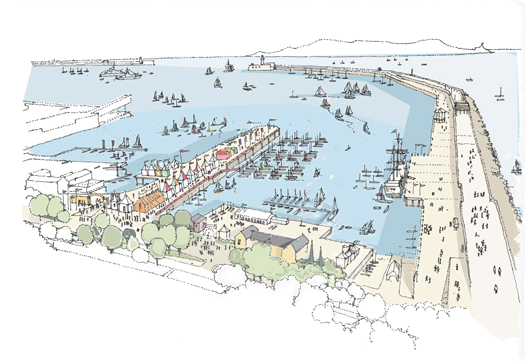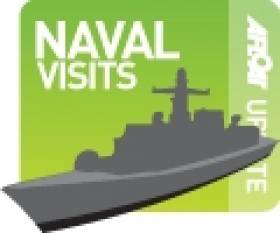Displaying items by tag: Solitaire du Figaro
French OPV ‘Guard-ship’ to Follow Figaro Fleet From Dun Laoghaire
The 447 tonnes OPV provides communication liaison and assistance should the forty six sailors require during the arduous race including SAR. As such the vessel can deploy a rapid response high speed RIB-craft from an internal dock-well located at the stern.
Otherwise the RIB is used to board fishing vessels as part of fishery monitoring duties and patrolling France's Exclusive Economic Zone out to 200 nautical miles (370 km). She is a Flamant class OPV and was built in 1997 by the Cherbourg based shipyard Constructions Mécaniques de Normandie. The 54m/177-ft craft is equipped with two 12.7mm machine guns.
As Dun Laoghaire is the only international port of call during the four-leg stages of the 1,695 nautical miles (3,390kms) the hosting of the Irish harbour is a welcomed boost to the sailing community and the local economy. Leading off the Carlisle Pier are pontoons where the one-design boats are moored and opposite is the East Pier jetty berth where the PSP Cormoran is docked.
Also at the East Pier is a festival market which is part of the Festival des Bateaux. The three-day festival ends tomorrow and was organised by the race-hosts the National Yacht Club, the Dun Laoghaire Harbour Company and Dun Laoghaire Rathdown County Council. For further festival details click HERE.
The presence of a foreign naval visitor to the harbour was more commonplace particularly during festivals held in the 1980's. In addition to the French, navies from Belgium, The Netherlands were regular festival participants.
- National Yacht Club
- Solitaire du Figaro
- Dun Laoghaire Harbour Company
- Dun Laoghaire Rathdown County Council
- Dun Laoghaire Harbour
- French Navy
- Festival des Bateaux
- Dun Laoghaire Harbour News
- Naval Visits
- PSP Cormoran
- Dun Laoghaire East Pier
- Dun Laoghaire pierheads
- Guardship
- Dun LaoghaireSables d'Lonne
- Vedee
- Dun Laoghaire Festivals
Dublin Bay it set to burst alive with 'joie de vivre' during the only foreign stopover in the world-famous Solitaire du Figaro yacht race.
Dun Laoghaire will be the only international stop in the race, considered the unofficial world offshore solo championship, between 11 and 14 August.
To celebrate the visit of the iconic 3,390km race, Dun Laoghaire Rathdown County Council (dlrcoco), the Dun Laoghaire Harbour Company and the National Yacht Club have joined forces to create the Festival des Bateaux.
The harbour will be a magnificent tapestry of colour as the boats arrive for this international event. Dun Laoghaire will be resplendent with fireworks, music and the sights, sounds, foods and ‘joie de vivre’ of France.

How Dun Laoghaire will look in August
Fireworks will light up the sky at 10pm on Friday 12 August. There will also be a festival village with public access to visiting boats, a colourful and authentic French market and exhibition, a festival stage at Harbour Plaza and activities throughout Dun Laoghaire, not to mention a spectacular farewell as the boats depart early on Sunday 14 August.
Meanwhile, plans to berth the 45 or so competitors expected are well underway, according to the National Yacht Club.
Funding was secured between dlrcoco and Fáilte Ireland, and the tender for the supply and delivery of 18x11.5m pontoons and associated service bollards was won by McNiven Marine, Irish agents for Ronautica Marine.
The gangway contract was secured by Tynes Gangway, and the last contract for the installation and de-commissioning of the infrastructure is currently underway.
Solitaire du Figaro: Irish Coast Beckons
The first night at sea of Leg 3 of La Solitaire du Figaro proved to be as demanding as expected, with the skippers fighting against high winds, cold weather, drizzling rain, fog and, especially, a very fastidious swell. Several blown spinnakers but the whole fleet is fastly sailing towards Ireland. After keeping the lead for more than 24 hours, Thomas Rouxel, has to lave first place to Armel Le Cleac'h. Yet, nothing is carved in stone as the first 26 boats are only 5 miles apart at 150 miles from the finish. Last night's Channel crossing from Portsal to Wolf Rock was wet and bumpy for the 44 skippers racing in the 41st edition of La Solitaire du Figaro. "Several skippers reported damages and breakages" said Jacques Caraes form the Race Management catamaran following the fleet's progress in the Celtic Sea. The big waves got the best of at least a dozen spinnakers.
Surely annoying but probably not so relevant for the rest of the race to Ireland because, in theory, the skippers will not need them to sail to Fastnet Rock and their final destination, Kinsale. The damage on Armel Tripon's Gedimat looks more serious, her hull pierced following a collision after the start in Brest. "On starboard tack there is a leak" reports Tripon, at the same time reassuring that the situation seems to be under control and keeps his spirits high. No doubt that shore teams, sail makers, riggers and builders will be busy over next week in Kinsale. For the sailors' joy the long, uncomfortable reaching in high winds up to 25 knots, grey and wet conditions came to an end early in the morning when the leaders rounded the Wolf Rock lighthouse and entered the Celtic sea. The first skipper to reach midpoint to the finish was a consistent Thomas Rouxel (Crédit Mutuel de Bretagne). The fleet later had to deal with a sudden 90° wind shift, provoked by the quick passage of a front, he wind from south westerly became north easterly. Sure enough there will be more of such variations to negotiate before seeing the famous Fastnet Rock, as confirmed by Meteo France's weather expert Sylvain Mondon: "the wind shifty and unstable, coming from the northern sector". No big news there, since before leaving Brest all the skippers declared that they very particularly wary of the Celtic Sea and its tactical tricks.
The tricky sea and hard tactical choices don't seem to be a major problem for Armel Le Cleach (Britair) who is reported to have got in the lead once again, overtaking Thomas Rouxel (Credit Mutuel de Bretagne) and preceding also Jean-Pierre Nicol (Bernard Controls) in third.
Yet the skippers are sailing in a very compact group, only 4.5 miles separate the leader from the 26th placed, Italian Pietro D'Alì (I.NOVA.3). Yet, another brilliant performance to register from Portuguese Francisco Lobato (ROFF/TEMPO-TEAM), who's been in the leading pack since the start and now lies in 12th position only two miles behind Le Cleac'h and first in the newcomers special ranking. Franco/German Isabelle Joschke (Synergie) is 25th, Swiss Bernard Stamm (Cheminées Poujoulat) is 35th and Jonny Malbon (Artemis) is in 42th at ten miles from the top. As per the latest computer simulations the ETA for the leaders at the Fastnet could be tomorrow between 9 and 12 GMT while the leaders could be crossing the finish line at Old Head of Kinsale. Quotes from the skippers:Corentin Douguet (E.Leclerc Mobile)"The wind shifted by 90° all of a sudden, it nearly got me by surprise. I had to tack quickly and now we are on port. We were heading to target on starboard before and we are doing in now on the opposite tack! We are approaching the Fastnet faster than expected, We've been busy since the start, no waiting game and it should be like that to the Rock, a tight schedule. It's windy but the swell is more annoying, rough and the autopilot is not working 1005 in these conditions. You must steer.
Typical August day in the Celtic sea. I't getting better, the visibility is improving, until a hour ago you can't see anything. Still, I like to be here." Armel Le Cléac'h (Brit Air)"After Brittany Point, a long tack and after rounding Wolf Rock there was a huge wind shift, more than 100°, from SW to NE, the breeze is coming from everywhere... The night was all right, I was happy to have left Brest in a good position, I was afraid of getting stuck somehow in the gulf. The sea is confused, we have a long stretch upwind tacking to the Fastnet, it won't be easy to find the best track to Kinsale. I keep my fingers crossed." Yann Eliès (Generali Europ Assistance)"A front just passed, the wind shifted abruptly but the rain has stopped and it's good after a whole night spent under, literally, buckets of water! You couldn't see much out there. I tried to go West and a cargo ship made a u turn just in front of me, I was obliged to take down the spinnaker. I lost some ground, even if I'm always in the top pack. There are still options to be made: a ridge, wind shifts, all the upwind part to the Irish coast that's going to be fun..."
Preparing for La Solitaire du Figaro here
Latest news for La Solitaire du Figaro hereThe 44 skippers taking part to Leg 3 of the Solitaire du Figaro left Brest today for a 349 miles long route bound for Kinsale. The start was hampered by the bulk of the fleet clustering the pin end of the line, causing individual recalls and several protest flags to be raised. Leaving the goulet de Brest prove to be as hard as expected with collisions, penalty turns and a boat actually hitting the rocks. Portuguese skipper, Francisco Lobato, rounded the Radio France mark in 5th position ahead of his fellow first time participants.
Skippers left the pontoons from 11.00 waving goodbye to shore teams, families, friends and supporters ready to embark on the 349 miles of pure competitive sailing to Kinsale, together with La Belle Poule, the French Naval tall ship who hoisted her full set of sails, offering an spectacular and rare show for the gathered public out to watch the start.
Even before the start procedure was given, the atmosphere was full of excitement and expectation. At the start several boats were over the line, some going back to take a penalty and re-start, but the situation was pretty confused and many skipper's decided to hoist the protest flag. At the weather mark, the bouée Seamobile, two boats collided and further penalty turns ensued.
At the Radio France mark, the much-appreciated first prize went to François Gabart on Skipper Macif 2010, who was followed by Thomas Rouxel on Crédit Mutuel de Bretagne and Sébastien Josse on Vendée. Young Portuguese newcomer to the Figaro, Francisco Lobato on ROFF/TEMPO-TEAM had an excellent start to then round the mark in fifth, first among the rookies. Other non French skippers were reported to be in the second half of the fleet: Swiss Bernrd Stamm in 29th, Italian Pietro D'Alì in 36th, Jonny Malbon in 39th and Franco/German Isabelle Joschke in 43rd.
Shortly after rounding the Radio France buoy, Gabart ran onto the rocks whilst sailing very close to shore. He was forced to get off the boat and was then able to literally push the boat off the rocks without requesting outside assistance and immediately went back to racing.
Upon leaving Brest and the bay of Camaret, the fleet made course up to the Four Channel, which can prove to be a very complex stretch of the course, especially renown for the tough cross currents. The Molène archipelago and the isle of Ushant will have to be left to port side, then the Portsall plateau leaving the cardinal mark west Grande Basse de Portsall to port side. The leaders could get there, according to the latest ETA tonight between 8 and 9 p.m.
The fleet will then begin the second part of the leg that will take the skippers across the Channel towards Wolf Rock, which must be left to port. The fleet is expected to reach Wolf Rock around breakfast time Tuesday.
Kinsale will welcome the 2010 Solitaire du Figaro for the 19th time in the 41-year history of the classic summer race, the highest number of visits received by any venue to have hosted the race stops.
Quotes from the skippers in Brest, before leaving for Leg 3
Pietro D'Alì (I.NOVA.3)
"This is not going an easy leg but at least it's going to be fast. The latest weather report says there will be more wind that we thought, so it will probably less hard to get out of the gulf. The cold front will come later than expected, there is a chance that we will round Wolf Rock reaching and then a long upwind part to the Fastnet. The wind will be pretty instable after that, we will need all our focus tacking up to Kinsale. The finish is expected for Wednesday might, it's going to be pretty quick... You will have to stay in the leading group from the start, not to accumulate too much distance, as apparently there will be no stop and go this time. I feel all right, especially after a massage and a good dose of sleep, I'm ready to go for the third one. I hope I will have the chance to fight to be in the top ten."
Armel Le Cléac'h (Britair)
"Sure, it's the shortest one, but we will be busy anyway. Getting out the goulet de Brest (bottleneck harbour) this afternoon against the current won't be easy, then the long tack to Cornwall, speed needed there, and the Celtic sea to complicate things further. Not simple at all, we'll have to watch out. As in any other leg... you can loose ground and be left behind. The start is tricky but the rest as well, with many options to take. I'm a bit tired, that's true because you never recover 100% of your energies. We are midpoint now with a tricky leg to be dealt with. And it's not just all about speed, but there's also strategy, weather routing and we are under stress."
Jean-Paul Mouren (Marseillentreprises)
"I'm convinced it's going to be a good leg, as the previous ones. It will probably be less sunny when we'll get to Ireland; I have my umbrella ready... My wish? You know, choosing the right option or the wrong one takes exactly the same energy, so I will try and be on the right track, be at one with the weather. That's what you need to do, be on the same wavelength with nature, or it's going to be all wrong."
François Gabart (Skipper Macif 2010)
"We had two good ones, I must admit I'm biased because all went well for me. And for this one, we have all the right ingredients: light wind and current, then reaching under spinnaker or genoa; the Celtic Sea is going to be interesting too because there is a small secondary low pressure and there will surely be wind shifts to consider. Then another ridge and another front. A full plate for the game to be fun. I'm happy to get going because I feel all right, the boat is ready and I guess I got the rhythm. I need to go on sailing like I did on the previous two legs: look for maximum speed and try to be at the right place at the right moment."
Marc Emig (Marcemigetmoi.com)
"I need to learn to sail in the rain! More seriously, I wish to be able to stay in the top group, not to give up when things go wrong, be back in the match and get to Kinsale in a good mood with the longest possible lead. Then I will still have the last leg to try a coup and go up some 5 or 6 places."
Preparing for La Solitaire du Figaro here
Latest news for La Solitaire du Figaro hereAfter 13 Year Absence, Kinsale Gets Ready for French Invasion
The 44 skippers get ready for Leg 3 of the Solitaire du Figaro in a surprisingly sunny and warm Brest while hundreds of supporters crowd the race village and the pontoons. Tomorrow at 14.00 they will leave Brittany for a challenging new leg up to the Channel, the Celtic Sea, the famous Fastnet Rock and the stunning village of Kinsale, where they return after a 13 years long absence. 349 miles of close and demanding racing, in strong currents, choppy seas and stiff breeze. Plus some accurate strategy towards the finish. The game is not over and many are hunting for glory.
Skippers and shore teams are giving the final touches to the 44 Figaro II that tomorrow at 14.00 will leave Brest for 349 miles of pure competition to Kinsale.
After leaving Brest and the bay of Camaret, the fleet will sail back up the Four channel which may prove difficult due to weak winds, swell and cross currents. The Molène archipelago and the isle of Ushant will have to be left to port side, the Four channel will be left off the reefs of the Portsall plateau leaving the cardinal mark west Grande Basse de Portsall to port side.
The second part of the leg will take the fleet across the Channel, approximately 90 miles to the Cornish coast, marked by Wolf Rock to be left imperatively to port side. The direct route will take the 44 skippers to sail between the Scilly Isles and Land's End. The 165-mile long sail up the Celtic sea will take the fleet to round the mythical Fastnet lighthouse, which will have to be left to starboard before heading East. The last stretch of around 45 nautical miles will surely be very hard for the tired sailors who will have to make use of their last energies to get to Kinsale, finish of leg 3, where the race has not returned to since its 28th edition in 1997. If this leg is the shortest, it certainly will not be the easiest. The passage along the coast of Finistère and the long and complex route from the Fastnet to Kinsale will no doubt be the hardest parts of this leg to negotiate.
According to the latest weather bulletin issued by Meteo France expert Sylvain Mondon the skippers will have to deal with a first part relatively good as far as wind is concerned, with a south westerly breeze of 10/14 knots that will accompany them to the Scilly. The wind will later strengthen due to a front hovering over the area and the sea state will be particularly hard to tackle.
Apart form the French stars such as Le Cleac'h, Gabart, Rouxel, Beyou or the best placed female skipper Jeanne Gregoire and the first rookie Anthony Marchand, the international skippers are also ready to fight for a "personal best" in Leg 3 or to take their revenge after somehow disappointing performances. So far the top spot among the non-French goes to expert Swiss Bernard Stamm (who is is also third placed in the newcomers special ranking, racing his first Solitaire ever) in 18th, French/German Isabelle Joschke is 28th, Italian Pietro D'Alì is 31st, Portoguese Francisco Lobato is 38th and unlucky Briton Jonny Malbon, who suffered an autopilot failure in Leg 2 and was forced to steer for three days, is in last position but ready to strike back.
Kinsale will welcome the 2010 Solitaire du Figaro for the 19th time in the 41-year history of the race. Kinsale still is the location to have hosted the highest number of legs of the race. No doubt the skippers will be eager to discover or rediscover this charming village, which has so strongly marked the life of the event.
Quotes from the skippers in Brest, at midpoint in the 2010 Solitaire
Bernard Stamm (Cheminées Poujoulat)
"From a racing standpoint it's an average performance, I'm 18th, at mid fleet. I still make so many different mistakes, I guess I'm still far from the leaders' level but it does not come as a surprise. I find what I came looking for and I'm pretty satisfied, all considered. In the second leg I made a huge strategical error after Penmarch, that could have been even more costly. I didn't in the first leg, just had some speed issues and lost ground. I'm enjoying this close racing very much, it's funny to have always someone next to you. It's useful to keep learning, I'll try to keep the faults to a minumim and go up in the general ranking.
I would like to do more but the schedule for the 60' is already quite intense, the Figaro is not for amateurs , it's also physically very demanding, it's fun but hard."
Jeanne Grégoire (Banque Populaire)
"You have to suffer, in the Solitaire. Hurt yourself on the first leg is ok... but in the second one I really had to push to the limits to get closer to the top. This is what I did, worked hard, slept very little but still tried to think on the long term. And the leg was shorter. Everyone tells me that I'm in top form but I feel as usual, maybe I'm a bit sad because I miss my little one a lot (Jeanne had to skip last year's Solitaire to give birth to a baby girl ed. note) when I'm ashore. I could go home for a while and see her. I feel ok and my position suits me all right, five minutes from the fourth (Jérémie Beyou) but I only have a 30 minutes lead on the 14th, need to be on the lookout."
Romain Attanasio (Savéol)
"The third leg looks promising: at least we will have wind! But I'm wary, the shortest could be the trickiest. You will have to take a good start, deal with the contrary current, be in the leading group to the Scilly, then choose the right option in the Celtic Sea, tacking upwind. And watch out for the last 50 miles along the Irish coast, I hope we won't meet all together again in front of the finish line like it happened in Dingle. Experience show us that anything can happen up there. I find this year the technical level of the so called rookies is incredibly high. In the past being in the Top Ten was a big success, today being among the first half of the fleet is a feat! It takes twelve months for the young sailors to learn what we acquired in ten years!"
Reminder of the key dates:
- LE HAVRE
Suzuki Prologue: Sunday 25th July
Start of the 1st leg: Tuesday 27th July
- GIJON (515 miles)
Start of the 2nd leg: Tuesday 3rd August
- BREST (385 miles)
Start of the 3rd leg: Monday 9th August
- KINSALE (349 miles)
Expected arrival of the boats: Wednesday 11th August
Start of the 4th leg: Monday 16th August
- CHERBOURG-OCTEVILLE (435 miles)
Expected arrival of the boats: Thursday 19th August
Closing Parade: Sunday 22nd August
Preparing for La Solitaire du Figaro here
Latest news for La Solitaire du Figaro hereSolitaire du Figaro: Jury Decision Alters Scoreboard
As Kinsale gets ready to host the La Solitaire du Figaro single-handed sailors next week the race Jury met today in Brest to discuss the protest against Yann Eliès, who was forced to use his engine during the first leg to get off after going aground. The sailor was given a two hours penalty and as a consequence he falls from second to 19th place. Following the decision involving the skipper of Generali Europ Assistance the top part of the scoreboard has deeply changed.
The third leg of the race from Brest to Kinsale is 349 miles and it leaves Brest tomorrow.
Eliès got a 30 minutes penalty for breaking the engine seal plus an additional 1 and a half hour for infringing the propulsion rule, two hours in total, that's the judgement for Yann Eliès. Going aground on the beach at Primel is costing dearly to the skipper from Saint-Brieuc: he goes down from second at 51 minutes and 58 seconds from leader Armel le Cleac'h to 19th distanced of nearly three hours in the general ranking after two legs. He then has to change his goal of winning the 2010 Solitaire, a hard not to say impossible target to reach.
As it happens in sail racing, for nearly every decision from the Jury, this will be judged too heavy or too light according to the profit anyone makes of it, but this one is without appeal and will have to be accepted as it is.
As a result the leader Armel Le Cléac'h (Brit Air) gains another 13 minutes on his immediate follower who is François Gabart (Skipper Macif 2010) at 1hour 04' and Thomas Rouxel (Crédit Mutuel de Bretagne) jumps on the podium at 1hour 31 minutes from Le Cléac'h. In the Top Ten positions in goes a skipper form the Med, that is to say Kito de Pavant (Groupe Bel), still at 2hours 08' but now in tenth position. Between him and the top three everyone keeps his or her position but goes up one place. Jérémie Beyou (BPI) is 4th at 1hour 43 minutes; Jeanne Grégoire (Banque Populaire) fifth at 1.48; Fabien Delahaye (Port de Caen-Ouistreham) sixth at1.54; Erwan Tabarly (Nacarat) seventh at 1.56; Gildas Morvan (Cercle Vert) eight at 1.58; Eric Peron (Skipper Macif 2009) ninth at 2.01. To be noted that ait's a very small time difference that separated the fourth to the tenth placed skipper: only 25 minutes. The podium for the newcomers is also affected by this new general ranking with each of the rookies going up one step: Anthony Marchand (Espoir Région Bretagne) is now 12th at 2.14, Yohann Richomme (DLBC) 14th at 2.18 and Swiss Bernard Stamm (Cheminées Poujoulat) 18th at 2.47.
During today's meeting the Jury also inflicted a 20 minutes penalty to Sébastien Josse (Vendée) for breaking his engine seal following some issues in recharging his batteries. This decision, in fact, has no direct consequence on Josse's general ranking: he still occupies the 34th position at 5.56 from the leader.
Yann Eliès (Generali Europ Assistance) comments the Jury's decision:
"The penalty was not easy to accept at first. Now, in retrospective I believe it is a good decision. You can't let a skipper who used his engine win a race as important as the Solitaire du Figaro. It's a question of fair play and image, and I'm one of the strongest believer in this concept. I've got 48 hours to try and recover, get mentally ready to go on racing. I wish to do something good, why not winning a leg to finish my Solitaire with my pride intact?"
Jean-Bertrand Mothes Massé, President of the Jury:
"Despite considering that Yann has made a serious mistake for a professional sailor going aground, the Jury is also convinced that he acted with seamanship, using his skills to save his boat. Moreover he did not ask for outside assistance. We then decided to increase the penalty established by the class and the racing rules."
At noon today the Figaro Race Village hosted a crowded prize giving ceremony, in groups of four all the skippers went on the scene for a short speech and to get a well deserved applause.
Preparing for La Solitaire du Figaro here
Latest news for La Solitaire du Figaro here

































































